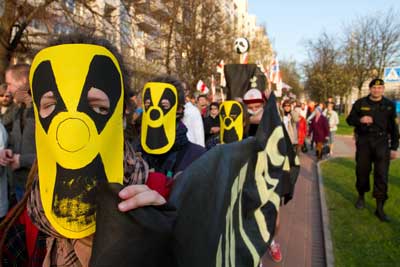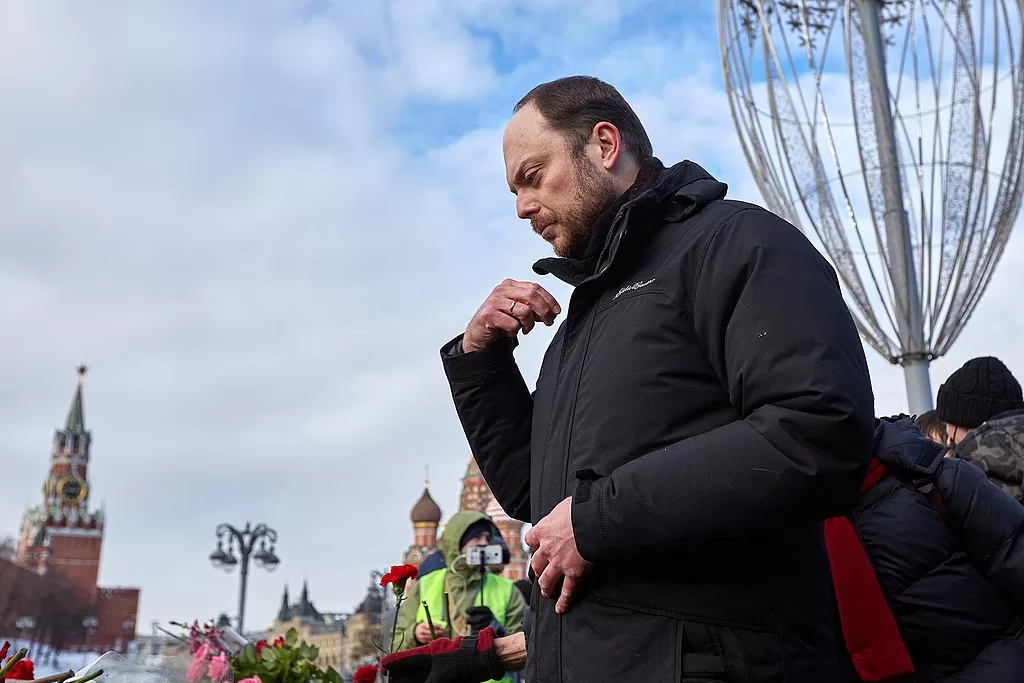Twenty-seven years after the worst nuclear power accident in history, Aliaksandr Zianchuk reports on the invisible catastrophe in Belarus
Twenty-seven years after the Chernobyl disaster a whole generation of Belarusians has grown with no memories of the incident of 26 April 1986, when a nuclear reactor exploded in north-east Ukraine, just on the border with Belarus. Settlements that had been abandoned after the disaster almost disappeared: some of them were razed to the ground, others were inhabited again. The Belarusian media usually remind us of Chernobyl and its aftermath once a year, on the anniversary of the explosion.

Activists participated in last year’s annual Chernobyl Way remembrance rally in Minsk. Photo: Alexander Mazurkevich/Demotix
There are almost no significant memorials of the Chernobyl disaster in Belarus; just a small church in Friendship of Nations Park in Minsk and tiny monuments in southern districts of the country that were affected by radiation. This is why it is quite difficult to communicate the feelings about that “invisible catastrophe” to people who don’t remember.
“The Chernobyl nuclear disaster is now perceived by people as some kind of shared heritage or even national achievement. Just as ‘We survived the war’ Belarusians think ‘We survived Chernobyl’, says Yahor Lebiadok, a deputy of a local council from Smaliavichy. “It feels like a part of a national message of pride: nothing or nobody can take us bare-handed, we can survive anything. So, Chernobyl nowadays is perceived as just a cliché of a threat.”
The authorities are quite good at using state media and propaganda to change the focus of public attention.
“It is not in their interest to put this focus on the issue of Chernobyl, because in this case they would have had to change their policy. If the government admits the problem of the Chernobyl aftermaths still exists, they would have put additional efforts into solving it, and spend additional funds,” says Piotr Kuzniatsou, a blogger and a human rights activist.“This means state media are allowed to mention Chernobyl only once a year, and are silent about the issues of radiation pollution and the affected areas,” Nastassia Zianko, a Belarusian journalist, admits. “Chernobyl media coverage is rarely investigative and deep — usually it is just reportage from the area, local villages or small towns. But the issue as a whole is very complicated; to do a good story one has to spend months researching and looking for information.”
As a result public opinion sees the topic of Chernobyl as less and less important; current social and economic issues push it into the media background. To avoid spending money on the elimination of outcomes of the disaster and rehabilitation of affected areas, the authorities try to persuade the Belarusians not to think of Chernobyl as something dangerous.
This strategy seems to work — despite cases when practical interests of particular people are at stake. For instance, inhabitants of several areas whose status had been changed from “polluted” to “clean” were unhappy to lose state benefits they received as compensation for living in districts affected by radiation.
“Chernobyl-affected regions have cheap labour forces, so it is profitable to run enterprises there. For instance, Belarusian agriculture inherited Soviet ‘extensive approach’; it means increasing production by mere expansion of cultivation areas instead of increasing the quality, breeding new varieties of products or crops or adopting new technologies. So, nowadays previously abandoned fields in polluted areas are being cultivated, and agricultural products from affected districts are being distributed around the country,” Piotr Kuzniatsou says.
Research done by Yury Bandazheuski, PhD, in Homiel Medical University proved that radionuclides affect organs of the human body when they penetrate an organism with polluted food. They cause so-called “inner radioactive irradiation”, which is more harmful than background exposure, but this is not included into estimates of influence of radiation on people.
Every year Belarusian sanitary and health services register the facts of radioactive pollution of food people bring from their farms to markets or in mushrooms they pick in forests. There is a question why such a vivid threat Chernobyl still poses to the country and its population doesn’t make it into a burning topic for Belarusians.
Time makes people forget, Natallia Alifirovich, a psychologist, says: “Psychological mechanisms of suppression and denial are quite powerful. Suppression means memories of an unpleasant event are placed in parts of the brain where they are inaccessible for a mind; denial helps people believe an unpleasant event won’t happen for the second time.”
But the Fukushima nuclear disaster in Japan in March 2011 showed catastrophes happen again and again — despite any level of safety.
Another important reason for the authorities not to talk about Chernobyl is their plans to build a nuclear power station in Belarus.
Civil society groups remain alarmed by the consequences of the Chernobyl nuclear disaster and the prospects of building a nuclear power plant in Belarus. The issue is addressed by ecological and humanitarian NGOs, but due to the political situation they lack effective mechanisms of raising it to the level of decision-making.
“People who live in polluted areas know radiation is dangerous, but in practice they don’t do much to protect themselves. There is no special policy on health care for people who live in the polluted areas. Although some activities aimed at decreasing the impact of the catastrophe have been carried out, the state refuses to admit the real extent of the problem and finance recovery and rehabilitation from the Chernobyl aftermaths,” Andrei Yahorau says.
As the authorities push for building of a new nuclear plant in Belarus, they should be responsible for informing people about nuclear safety and behaviour in case of an emergency situation. But the government of Belarus can actually build the station without telling people about safety, Yahorau admits.
“This is exactly what is happening right now. The nuclear plant is being built near Astravets, close to the Lithuanian border; the local population has no information about the real threats a new plant can contain. The state propaganda machine works to convey a message that the plant is absolutely safe, that new technologies are used while building it, and that nothing can go wrong,” the expert says.
According to Yahor Lebiadok, the topic of Chernobyl in Belarus has always been political, as “both the authorities and the opposition have used it in their own interests”: “It is quite difficult for people who are not experts to actually differentiate between a real threat and mere politicking.”
In the case of nuclear power, access to information can become a question of life and death – or at least a question of personal safety and health.
Aliaksandr Zianchuk is a Belarusian journalist





